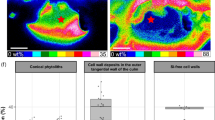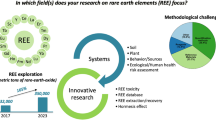Abstract
There are no results of comparative ecological studies of the radionuclide activity concentration in the plants and soil in relation to geological substrate. Presented research encompasses the comparative analysis of the concentration of four radionuclides, three natural (40K, 226Ra, 232Th) and one artificial (137Cs) in soil samples and aerial plant parts of Teucrium montanum from different natural habitats on serpentinite and calcareous geological substrate. The activity concentrations of radionuclides were measured with high purity germanium (HPGe) detector and expressed as Bq kg−1. The calculated activity concentrations of 40K, 226Ra, 232Th, and 137Cs in soil samples from serpentinite/calcareous habitats are in range 39.6–91.0/59.3–1018.8, 1.7–5.5/4.3–52.4, 2.4–10.9/5.9–72.9, and 57.2–844.9/29.6–701.5 Bq kg−1, respectively. The activity concentrations of 40K, 226Ra, 232Th, and 137Cs in plant samples are in range 152.9–445.9/228.0–521.4, n.d.–1.2/0.6–5.6, n.d./0.2–0.9, and 1.0–46.4/1.7–7.0 Bq kg−1, respectively. The obtained results showed that the quantities of 137Cs are greater in the soil and plant material from the serpentinite habitats, while quantities of 40K, 226Ra, and 232Th are greater in the soil and plant material from calcareous habitats. In general, the level of radioactivity in plants and soil depends on the type of the geological substrate. The content of radionuclides in plants is correlated with the radionuclide content in the soil. In addition to other specifics in physical and chemical properties, serpentinite habitats are characterized by an increased amount of Cs in the soil, which causes an increased amount of this radionuclide in plants such as Teucrium montanum.
Similar content being viewed by others
References
Ababneh, A. M., Almomani, A. M., Alyassin, A. M., Ababneh, Z. Q. (2011). Distribution of natural and anthropogenic radionuclides in heavy rainfall areas in Jordan. Radiation Protection Dosimetry, 1–9.
Adriano, D. C., McLead, K. W., & Ciravolo, T. C. (1984). Long-term root uptake of radiocaesium by several crops. Journal of Plant Nutrition, 7, 1415–1432.
Al-Hamarneh, I. F., & Awadallah, M. I. (2009). Soil radioactivity levels and radiation hazard assessment in the highlands of northern Jordan. Radiation Measurements, 44, 102–110.
Baltas, H., Yesilkanat, C. M., Kiris, E., & Sirin, M. (2019). A study of the radiological baseline conditions around the planned Sinop (Turkey) nuclear power plant using the mapping method. Environmental Monitoring and Assessment, 191, 660.
Brooks, R. R. (1987). Serpentine and its vegetation: A multidisciplinary approach. In T. R. Dudley (Ed.), Ecology, phytogeography, and physiology series (p. 454). Dioscorides Press.
Bunzl, K., Albers, B., Schimmack, W., Belli, M., Ciuffo, L., & Menegon, S. (2000). Examination of a relationship between 137Cs concentrations in soils and plants from alpine pastures. Journal of Environmental Radioactivity, 48, 145–158.
Darabi-Golestan, F., Hezarkhani, A., & Zare, M. R. (2019). Geospatial analysis and assessment of 226Ra, 235U, 232Th, 137Cs, and 40K at Anzali wetland, north of Iran. Environmental Monitoring and Assessment, 191, 390.
Djelic, G., Krstic, D., Stajic, J. M., Milenkovic, B., Topuzovic, M., Nikezic, D., et al. (2016). Transfer factors of natural radionuclides and 137Cs from soil to plants used in traditional medicine in central Serbia. Journal of Environmental Radioactivity, 158–159, 81–88.
Gaspar, L., & Navas, A. (2013). Vertical and lateral distributions of 137Cs in cultivated and uncultivated soils on Mediterranean hillslopes. Geoderma, 207–208, 131–143.
Giannakopoulou, F., Haidouti, C., Chronopoulou, A., & Gasparatos, D. (2007). Sorption behavior of cesium on various soils under different pH levels. Journal of Hazardous Materials, 149, 553–556.
Habib, M. A., Basuki, T., Miyashita, S., Bekelesi, W., Nakashima, S., Techato, K., et al. (2019). Assessment of natural radioactivity in coals and coal combustion residues from a coal-based thermoelectric plant in Bangladesh: Implications for radiological health hazards. Environmental Monitoring and Assessment, 191, 27.
Hanfi, M. Y., Mostafa, M. Y. A., & Zhukovsky, M. V. (2020). Heavy metal contamination in urban surface sediments: Sources, distribution, contamination control, and remediation. Environmental Monitoring and Assessment, 192, 32.
Hirose, K., Kikawada, Y., Igarashi, Y., Fujiwara, H., Jugder, D., Matsumoto, Y., et al. (2017). Plutonium, 137Cs and uranium isotopes in Mongolian surface soils. Journal of Environmental Radioactivity, 166, 97–103.
Jevremovic, M., Lazarevic, N., Pavlovic, S., & Orlic, M. (2011). Radionuclide concentration in samples of medicinal herbs and effective dose from ingestion of 137Cs and natural radionuclides in herbal tea products from Serbian market. Isotopes in Environmental and Health Studies, 47, 87–92.
Kabata-Pendias, A. (2011). Trace elements in soils and plants. 4 ed. New York: Taylor and Francis Group Boca Ration: CRC Press.
Kam, E., Bozkurt, A., & Ilgar, R. (2010). A study of background radioactivity level for Canakkale, Turkey. Environmental Monitoring and Assessment, 168, 685–690.
Kandić, I., Kandić, A., Čeliković, I., Gavrilović, M., & Janaćković, P. (2020). Activity concentrations of 137Cs, 40K, and 210Pb radionuclides in the selected medicinal herbs from Central Serbia and their effective dose due to ingestion. Science of the Total Environment, 701, 1–21. https://doi.org/10.1016/j.scitotenv.2019.134554
Krstić, D., Nikezić, D., Stevanović, N., & Jelić, M. (2004). Vertical profile of 137Cs in soil. Applied Radiation and Isotopes, 61, 1487–1492.
Krstić, D., Nikezić, D., Stevanović, N., & Milivojević, J. (2007). Determination of the soil-to-grass transfer of 137Cs and its relation to several soil properties at various locations in Serbia. Isotopes in Environmental and Health Studies, 43, 65–73.
Manigandan, P. K., & Manikandan, N. M. (2008). Migration of radionuclide in soil and plants in the Western Ghats environment. Iranian Journal of Radiation Research, 6, 7–12.
Nielsen, B., & Strandberg, M. (1988). A literature study of the behaviour of Cesium, Strontium and Plutonium in the soilplants ecosystem. Roskilde: Risö Nat. Labor., Agric. Res. Dep. Danish Atomic Energy Comm.
Nimis, P. L. (1996). Radiocesium in plants of forest ecosystems. Studia Geobotanica., 15, 3–49.
Njinga, R. L., Jonah, S. A., & Gomina, M. (2015). Preliminary investigation of naturally occurring radionuclides in some traditional medicinal plants used in Nigeria. Journal of Radiation Research and Applied Sciences, 8, 208–215.
Owens, P. N., & Walling, D. E. (1996). Spatial variability of cesium-137 inventories at reference sites: And example from two contrasting sites in England and Zimbabwe. Applied Radiation and Isotopes, 47, 699–707.
Ramola, R. C., Choubey, V. M., Prasad, G., Gusain, G. S., Tosheva, Z., & Kies, A. (2011). Radionuclide analysis in the soil of Kumaun Himalaya, India, using gamma ray spectrometry. Current Science, 100, 906–914.
Sikirić, B., Saljnikov, E., Stajković-Srbinović, O., Jaramaz, D., Čakmak, D., & Mrvić, V. (2018). Agrochemical characteristics of soils on Priijepolje municipality. Soil and Plant, 67, 36–45.
Stanković, S. M. (2012). Biological effects of secondary metabolites of species from the genus Teucrium L. of Serbian flora. Kragujevac, University of Kragujevac, Dissertation.
Takada, M., Yamada, T., Takahara, T., & Okuda, T. (2016). Spatial variation in the 137Cs inventory in soils in a mixed deciduous forest in Fukushima, Japan. Journal of Environmental Radioactivity, 161, 35–41.
UNSCEAR. (2000). Sources and effects of ionizing radiation, report to general assembly, with scientific annexes. United Nations Scientific Committee on the Effects of Atomic Radiation.
UNSCEAR. (2008). Report to the General Assembly, Annex B: Exposure of the public and workers from various sources of radiation. United Nations Scientific Committee on the Effects of Atomic Radiation.
Van der Stricht, E., & Kirchmann, R. (2001). Radioecology: radioactivity and ecosystems. Belgium: UIR-IUR, Oupeye.
Woodruff, L. G., Cannon, W. F., Eberl, D. D., & Smith, D. (2009). Continental-scale patterns in soil geochemistry and mineralogy: Results from two transects across the United States and Canada. Applied Geochemistry, 24, 1369–1381.
Zlatić, M. N., Stanković, S. M., & Simić, S. Z. (2017). Secondary metabolites and metal content dynamics in Teucrium montanum L. and Teucrium chamaedrys L. from habitats with serpentine and calcareous substrate. Environmental Monitoring and Assessment, 189, 110.
Zlatić, N. M., & Stanković, M. S. (2019). Effects of calcareous and serpentinite parent material on the mineral characteristics of soils and plant material of Teucrium montanum L. (Lamiaceae). Environmental Monitoring and Assessment, 191, 564.
Funding
This study was funded by the Ministry of Education, Science and Technology Development of the Republic of Serbia (Grants No: 451–03-68/2020–14/200122 and 451-03-9/2021-14/200122).
Author information
Authors and Affiliations
Contributions
Nenad Zlatić: Conceptualization, collecting samples, software, and writing—reviewing and editing. Dragana Krstić: Methodology and software. Milan Stanković: Visualization, conceptualization, collecting samples, initial idea, and supervision.
Corresponding author
Ethics declarations
Conflict of interest
The authors declare no competing interests.
Additional information
Publisher's Note
Springer Nature remains neutral with regard to jurisdictional claims in published maps and institutional affiliations.
Rights and permissions
About this article
Cite this article
Zlatić, N.M., Krstić, D.Ž. & Stanković, M.S. Radioactivity level in relation to geological substrate: dynamics of natural and artificial radionuclides on Teucrium montanum L. (Lamiaceae) habitats. Environ Monit Assess 193, 749 (2021). https://doi.org/10.1007/s10661-021-09536-7
Received:
Accepted:
Published:
DOI: https://doi.org/10.1007/s10661-021-09536-7




